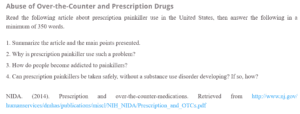Abuse of Over-the-Counter and Prescription Drugs
Over-the-counter (OTC) and Prescription drugs are the most common substances of abuse after alcohol and marijuana by Americans older than fourteen years (NIDA, 2014). The most commonly abused prescription medication classes include opioid painkillers such as Vicodin, psychostimulants such as Ritalin, and antidepressants such as Xanax. The most commonly abused OTC drug is dextromethorphan-based cough suppressants. There is a common misconception that OTC and prescription medications are safer than illegal drugs, but this is only accurate when taken in the correct manner prescribed. These medications are addictive and have adverse health effects when abused or taken with other drugs, such as alcohol.
Do you need help with your assignment ? Contact us.
The main ways prescription drugs are abused include taking medications that have been prescribed for someone else, taking the drug in a way other than prescribed, and taking the drug for purposes other than intended. When abused, prescription and OTC drugs cause an increase in dopamine levels, which is responsible for feelings of pleasure in the brain. Users will want to have this feeling all the time, which can lead to addiction. These medications have adverse effects such as tachycardia, arrhythmias, seizures, heart failure, paranoia, drowsiness, constipation, and respiratory depression, mainly caused by opioids, which can be fatal. Dextromethorphan can cause impairment of motor functions, nausea, numbness, vomiting, tachycardia, and increased blood pressure. Continued use of these drugs can cause physical dependence and withdrawal symptoms when stopped. They can also lead to addiction and judgment impairment (NIDA, 2014).
Prescription opioid painkillers are a problem since these drugs are subject to patient abuse. The abuse of these medications has negative medical consequences on the patient. Opioid painkillers cause physical dependence and addiction when used for long. They can lead to drowsiness, affect the cardiovascular system, or even cause respiratory depression, and they can even cause death when overdosed (Pezalla et al., 2017).
Opioid painkillers act on mu receptors in the brain. This will then cause the brain to release endorphins. These endorphins make the patient feel good. Endorphins mute the patient’s pain perception and increase pleasure. This creates a temporary but rewarding sense of pleasure. When the effects of opioids wear off, the patient wants the good feelings back. This is always the first step towards addiction. Repetitive use of these drugs will lead to feelings of cravings, causing addiction (Koob, 2020).
It is possible to take opioid painkillers safely without the risk of developing physical dependence. This can be done by using the medication as prescribed, storing the drugs safely, not sharing it with anyone, not taking these drugs with other substances such as alcohol, and seeking medical help when signs of addiction start setting in (Park & Otte, 2019).
References
Koob, G. F. (2020). Neurobiology of opioid addiction: opponent process, hyperkatifeia, and negative reinforcement. Biological psychiatry, 87(1), 44-53.
NIDA. (2014). Prescription and over-the-counter medications.
Park, K., & Otte, A. (2019). Prevention of opioid abuse and treatment of opioid addiction: current status and future possibilities. Annual review of biomedical engineering, 21, 61-84.
Pezalla, E. J., Rosen, D., Erensen, J. G., Haddox, J. D., & Mayne, T. J. (2017). Secular trends in opioid prescribing in the USA. Journal of Pain Research, 10, 383.
ORDER A PLAGIARISM-FREE PAPER HERE
We’ll write everything from scratch
Question
Abuse of Over-the-Counter and Prescription Drugs

Abuse of Over-the-Counter and Prescription Drugs
Read the following article about prescription painkiller use in the United States, then answer the following in a minimum of 350 words.
- Summarize the article and the main points presented.
- Why is prescription painkiller use such a problem?
- How do people become addicted to painkillers?
- Can prescription painkillers be taken safely without a substance use disorder developing? If so, how?
NIDA. (2014). Prescription and over-the-counter medications. Retrieved from http://www.nj.gov/
Post your response in the Journal Dropbox.

